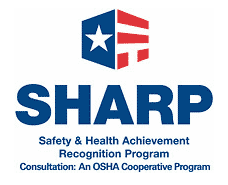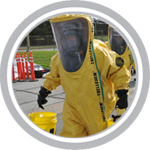HAZWOPER Training Resources
OSHA developed the Hazardous Waste Operations and Emergency Response Standard (HAZWOPER) program to protect the workers working at hazardous sites and devised extensive regulations to ensure their safety and health.
To find out more information about HAZWOPER and OSHA, check out the resource categories below:
- HAZWOPER Info
- HAZWOPER Links
- OSHA Links
- SHARP
HAZWOPER General Info
Hazardous Waste Operations and Emergency Response (HAZWOPER) is a set of guidelines produced and maintained by the Occupational Safety and Health Administration which regulates hazardous waste operations and emergency services in the United States and its territories. With these guidelines, the U.S. government regulates hazardous wastes and dangerous goods from inception to disposal.
The HAZWOPER standard provides employers, emergency response workers, and other workers potentially exposed to hazardous substances information and training criteria to improve workplace safety and health and reduce workplace injuries and illnesses that could occur from exposures to hazardous substances.
Hazardous waste, as defined by the standard, is a waste (or combination of wastes) according to 40 CFR §261.3 or substances defined as hazardous wastes in 49 CFR §171.8.
Mandatory Required Training
The OSHA HAZWOPER Standard (29 CFR Part 1910.120) – requires that all workers that are exposed to or handle hazardous materials:
- Are required take a 24 hour or 40 hour HAZWOPER Training Course; and
- An 8hr Annual Refresher Course;
- At a level required by their job function and responsibility; and
- Before they are permitted to engage in hazardous waste operations that could expose them to hazardous substances.
All of our courses comply with OSHA regulations. Receive your certification with our 24- or 40-hour course, or renew your HAZWOPER certification with our 8-hour refresher.
Three Levels of HAZWOPER Training
The HAZWOPER regulations contain 3 levels of training for personnel.
- Emergency Response - 29 CFR 1910.120 (q);
- General Site Cleanup - 29 CFR 1910.120 (e); and
- Resource Conservation Recovery Act (RCRA) Treatment, Storage and Disposal Facilities (TSDF) - 29 CFR 1910.120 (p).
Five HAZWOPER Operation Types
The standard describes five operations that fall within the regulation’s scope with three training-types that have unique learning objectives and varying training-hours requirements.
HAZWOPER applies to five groups of employers and their employees. This includes employees who are exposed (or potentially exposed) to hazardous substances (including hazardous waste) and who are engaged in one of the following operations as specified by OSHA 1910.120(a)(1)(i-v) and 1926.65(a)(1)(i-v):
- Cleanup operations required by a governmental body (federal, state, local or other) involving hazardous substances conducted at uncontrolled hazardous-waste sites.
- Corrective actions involving clean-up operations at sites covered by the Resource Conservation and Recovery Act of 1976 (RCRA) as amended (42 U.S.C. 6901 et seq.).
- Voluntary cleanup operations at sites recognized by a federal, state, local, or other governmental body as uncontrolled hazardous-waste sites.
- Operations involving hazardous waste which are conducted at treatment, storage and disposal (TSD) facilities regulated by Title 40 of the Code of Federal Regulations, parts 264 and 265 pursuant to the RCRA, or by agencies under agreement with the U.S. Environmental Protection Agency to implement RCRA regulations.
- Emergency response operations for releases of, or substantial threats of release of, hazardous substances (regardless of the hazard's location).
The most commonly used manual for HAZWOPER activities is Department of Health and Human Services Publication 85–115, Occupational Safety and Health Guidance Manual for Hazardous Waste Site Activities. Written for government contractors and first responders, the manual lists safety requirements for cleanups and emergency-response operations.
HAZWOPER Links
The HAZWOPER standard for the construction industry (29 CFR 1926.65) is identical to 29 CFR 1910.120. For brevity, the HAZWOPER standard is referenced as 29 CFR 1910.120 throughout the remainder of this web page. In limited exceptions, the HAZWOPER standard for construction provides examples or references to other standards for the construction industry that vary from what are provided in the HAZWOPER standard for general industry.
OSHA/Interagency Guidance Documents
- Hazardous Waste Operations and Emergency Response. Publication 3114, (Revised 1997).
- Training Marine Oil Spill Response Workers under OSHA's Hazardous Waste Operations and Emergency Response Standard. Publication 3172, (2001).
- Hospitals and Community Emergency Response - What you need to know. Publication 3152, (1997).
- 29 CFR 1910.120 Appendix E/29 CFR 1926.65 Appendix E. Non-mandatory guidance for general industry to assist employers in developing a site-specific training curriculum to meet HAZWOPER requirements.
- Emergency Action Plans: How to Plan for Workplace Emergencies and Evacuations. OSHA Publication 3088, (2001).
- Best Practices for Hospital-Based First Receivers of Victims from Mass Casualty Incidents Involving the Release of Hazardous Substances. Publication 3249, (2005). This document offers useful information to help hospitals create emergency plans based on worst-case scenarios. It focuses on suggestions for appropriate training and suitable personal protective equipment for healthcare workers who may be exposed to hazardous substances when they treat victims of mass casualties. The document includes appendices with practical examples of decontamination procedures and medical monitoring for first receivers who respond to a mass casualty incident.
- Principal Emergency Response and Preparedness: Requirements and Guidelines. Publication 3122, (2004).
- Incident Command System Resource Center. Federal Emergency Management Agency (FEMA) Emergency Management Institute.
- Safety and Health Awareness for Oil Spill Cleanup Workers. National Environmental Health Sciences, National Institutes of Health (NIH), Department of Health and Human Services (HHS); and Occupational Safety and Health Administration (OSHA), U.S. Department of Labor (DOL). Training tools for employers and workers who will participate in an oil spill response and cleanup operation to ensure workers receive appropriate training and PPE.
For additional resources and information, please reference the Government Agency website directly:
- A-Z Index of All Government Agencies (Includes States)
- Alcohol & Tobacco Tax & Trade Bureau (TTB)
- Bureau of Alcohol, Tobacco, Firearms & Explosives (ATF)
- Bureau of Labor Statistics
- Centers for Disease Control & Prevention (CDC)
- Food & Drug Administration (FDA)
- NAICS Search
- National Institute of Occupational Safety & Health (NIOSH)
- Occupational Safety & Health Administration (OSHA)
- OSHA Establishment Search
- SIC Search
- United States Department of Agriculture (USDA)
- Army Corps of Engineers
- Environmental Protection Agency (EPA)
- Department of Transportation (DOT)
OSHA Federal and State Links
U.S. DOL Occupational Safety and Health Administration (OSHA) works to prevent injuries and protect the health of workers.
- US DOL Occupational Safety and Health Administration (OSHA), including the laws, regulations, and services.
- US DOL Employment Law Guide - Occupational Safety and Health
- Bureau of Labor Statistics
- Environmental Protection Agency
- National Institute for Occupational Safety and Health (NIOSH)
- Mine Safety and Health Administration (MSHA)
- National Transportation Safety Board (NTSB)
- Centers for Disease Control and Prevention, Injury and Violence Prevention and Control
- Children’s Safety Network
- Federal Emergency Management Agency
- National Highway Traffic Safety Administration
- National Safety Council
- Safe States
Chemical Information
- OSHA Occupational Chemical Database
- Toxnet – National Library of Medicine Toxicology Data Network
- Agency for Toxic Substances and Disease Registry (ATSDR)
- NIOSH Pocket Guide to Chemical Hazards
MSDS Sites
Nonprofit Organizations and Standards
- American Red Cross
- Electrical Safety Foundation
- National Safety Council
- American National Standards Institute (ANSI)
- National Fire Prevention Association
- Industrial Truck Standards Development Foundation
- American Welding Society
Training
- The Pacific Northwest OSHA Education Center (Seattle)
- Boise State University Center for Excellence for Environmental Health and Safety
- Rocky Mountain Center for Occupational and Environmental Health
- OSHA E-Tools (Web-Based Training Tools)
- Compliance Guidance on Training
- Heat Illness Educational Resources
- Stop Falls Educational Materials and Resources
- OSHA Educational Downloadable Videos
- OSHA Educational Publications
- New Compliance Assistance Products
- Alliance Program Participants Developed Products
- Training and Reference Materials Library
- Other Resources for Training
- Spanish Language Compliance Assistance Resources
- Introduction to OSHA
- Construction Focus Four Training
Safety Professional Organizations
- Snake River Chapter of the American Society of Safety Engineers
- American Board of Industrial Hygiene
- Board of Certified Safety Professionals
Other Safety Information
- OSHA Site Specific Targeting List
- Bureau of Labor Statistics Injury and Illness Data
- Mesothelioma Center
- SafetyInfo.com
- Toolbox Topics
Safety and Health Achievement Recognition Program (SHARP)
 The Safety and Health Achievement Recognition Program (SHARP) is designed to provide incentives and support to employers to develop, implement and continuously improve effective safety and health programs at their worksite. SHARP provides recognition for employers who demonstrate exemplary achievements in workplace safety and health. These companies are exempted from a general scheduled Federal OSHA inspection for one to two years.
The Safety and Health Achievement Recognition Program (SHARP) is designed to provide incentives and support to employers to develop, implement and continuously improve effective safety and health programs at their worksite. SHARP provides recognition for employers who demonstrate exemplary achievements in workplace safety and health. These companies are exempted from a general scheduled Federal OSHA inspection for one to two years.
How Can My Company Participate In SHARP?
To participate in SHARP, you must:
- Request a consultation visit that involves a complete hazard identification survey;
- Involve employees in the consultation process;
- Correct all hazards identified by the consultant;
- Implement and maintain a safety and health management system that, at a minimum, addresses OSHA’s 1989 Safety and Health Program Management Guidelines;
- Lower your company’s Lost-Workday Injury and Illness rate (LWDII) and Total Recordable Case Rate (TRCR) below the national average; and
- Agree to notify your state Consultation Project Office prior to making any changes in the working conditions or introducing new hazards into the workplace
For more information, visit the OSHA web page for SHARP programs.

